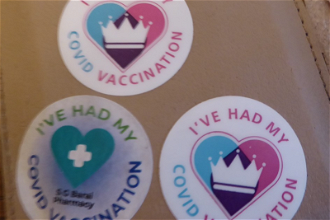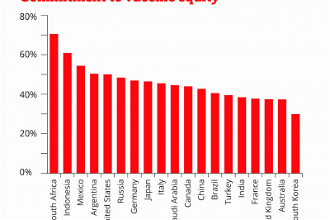Vaccines: 300 years of following the science

Professor Ian Linden
In his recent book, How To Make a Vaccine: An essential guide for COVID-19 & Beyond, Dr John Rhodes celebrates the 300th anniversary of the first well-recorded inoculation against smallpox in Britain in August 1721. At the time smallpox was killing up to 400,000 people in Europe every year including a grandchild of King George I.
The science of vaccination has made extraordinary strides. Our thinking about ethics only some modest positive developments. Vaccination opened up a set of important questions about the common good, choice and individual responsibility, misinformation, and latterly, moral indifference.
The story begins in Constantinople with the wife of the British Ambassador to the court of the Ottoman Sultan. Once a beauty, Lady Mary Wortley Montagu was disfigured by smallpox but survived to become an advocate of inoculation, or as she called it 'ingrafting', a practice performed on the Sultan's wives. Lady Montagu's son was successfully inoculated against smallpox in 1718. On her return to London a grand promotional event for the inoculation of her daughter was organised with royal court physicians including the King's physician, Sir Hans Sloane, in attendance.
The Princess of Wales, Caroline of Ansbach, well read in the science of the day, (later Queen as wife of George II), instigated an experiment with the aim of protecting her own children. Six prisoners due to be hanged in Newgate, were offered their lives and freedom if they volunteered as guinea-pigs to test the safety and effectiveness of inoculation, also called variolation. With celebrity endorsement from London's good and great this became a high profile event which Fellows of the Royal Society and some 25 members of the College of Physicians came to observe. In charge was the Scottish physician, Charles Maitland, a former embassy physician in Constantinople where he had learned the technique.
What followed was not for the faint-hearted.
Maitland made an incision into an arm and a leg of each convict and then inserted material from the pustules of an infected person. He had to repeat the procedure as not enough local reaction could be detected. One of the condemned received the material up the nose. A 19-year old girl who had been inoculated was later exposed to a child smallpox victim and proved to be immune. All six were given a royal pardon and walked free a month later. Public opinion about inoculation was divided and, as it is today, politicised: the Whigs at court justifying the experiment on utilitarian grounds and the Tories opposing it on grounds that physicians should not play God. The anti-vaxx movement in Britain had begun.
Doctors in Asia had been playing God and evoking opposition for many years. Rhodes quotes the Chinese emperor, K'ang-hsi in the late 1600s. "The method of inoculation having been brought to light during my reign, I had it used upon you, my sons and daughters….In the beginning when I had it tested on one or two people, some older person taxed me with extravagance, and spoke very strongly against inoculation. The courage which I summoned up to insist on its practice has saved the lives and health of millions of men".
The next big step, from inoculation to vaccination, came courtesy of a Gloucestershire milkmaid, Sarah Nelmes, who caught cowpox from a cow called Blossom. It's the better known story of two rural physicians, Edward Jenner and John Fewster, proving that pathogens administered in a weakened form could protect against a more virulent form. Result: millions of lives saved. Blossom's hide hangs on the library wall of St George's Medical School a bovine equivalent of Jeremy Bentham's stuffed hide displayed in University College London.
But there is a lot more to Rhodes informative book than some captivating medical history. He is at his most instructive teasing out the complexities of the human immune system, a little army of interactive defenders against foreign intrusion each with its own task: surveillance cells patrolling, helper T-cells, killer T-cells, B-cells which have daughter cells that produce the antibodies we've all heard about, regulatory T-cells that shut down the immune response once the pathogen is defeated, memory B-cells that, I imagine, must trigger the amplified response from a booster dose of vaccine, and memory T-cells. I wish the word awesome hadn't been voided of all meaning. The immune system is simply awesome. Though it can and does make mistakes.
How To Make a Vaccine is an important genre of science popularisation. It is clearly written but asks a lot of a reader without any biological or scientific background. Not because it is aimed primarily at a scientific audience but because it is narrating and explaining the intricate complexity of the immune system. There were well over two hundred different COVID vaccines at different stages of development as Rhodes was writing. They fall into eight distinctive categories depending on what part of the virus biochemistry is targeted and how: inactivated or attenuated forms of the virus, its DNA or messenger RNA or protein configuration for example. This is good news as variant mutations are unlikely to counter the effectiveness of all available vaccine categories.
Opposition to protective measures against viruses and bacteria has a long history. It has varied from Voltaire's jibe, that the British were 'fools and madmen' - not because they went out in the midday sun but because they promoted inoculation - to Andrew Wakefield's spurious claim in 1998 that the combined vaccination against measles, mumps and rubella, MMR, was linked to autism. The history indicates that a minority of the public will always be prone to making bad decisions about how best to look after their - and others' - children or their own health. And this will inevitably create public health problems.
Vatican guidance for Catholics has been preoccupied by the question of the origin of cell lines that have contributed to vaccine production - human foetal tissue from two sources in the 1960s - despite vaccination being of paramount concern for the common good in this pandemic. This has been at the expense of common good arguments for getting jabbed. The guidance concludes that the remoteness of the original 'evil act', abortion, removes any complicity from those seeking protection for themselves, family and others today. Indeed vaccination 'may be a moral obligation' if there are no other effective ways of stopping infection. Those who refuse in conscience must scrupulously find other ways of avoiding transmission of the virus. Scientists should obtain their cell lines without ending the development of a human life. Something tells me this is not going to sway militant anti-vaxxers.
How to Make a Vaccine is well worth the effort. The scientific progress it presents is in many ways comforting. It puts flesh on the dry bones of 'following the science'. Anti-vaxxers, especially those addicted to conspiracy theories, should ask themselves how the medical profession, with their Hippocratic Oath, has conspired to fool the world for the last three hundred years - and yet managed to save so many lives. And dip into this paperback. They won't even open it, of course. The persistence of opposition to vaccination based on nothing to do with conscience is sad, obstinate and dangerous.
Professor Ian Linden is Visiting Professor at St Mary's University, Strawberry Hill, London. A past director of the Catholic Institute for International Relations, he was awarded a CMG for his work for human rights in 2000. He has also been an adviser on Europe and Justice and Peace issues to the Department of International Affairs of the Catholic Bishops Conference of England and Wales. Ian chairs a new charity for After-school schooling in Beirut for Syrian refugees and Lebanese kids in danger of dropping out partnering with CARITAS Lebanon and work on board of Las Casas Institute in Oxford with Richard Finn OP. His latest book was Global Catholicism published by Hurst in 2009.
Visit his website here: www.ianlinden.com


















